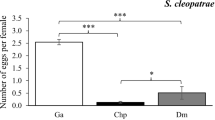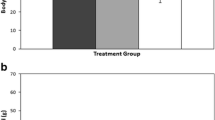Abstract
We tested whether and how the maternal environment (i.e. host species exploited by a mother), rearing conditions (i.e. host species exploited by her offspring) or both (i.e. matches and mismatches in host species exploited by a mother and her offspring) affect reproductive performance in the offspring. We experimentally manipulated maternal and rearing environments in two generalist fleas (Xenopsylla conformis and Xenopsylla ramesis) implementing a factorial cross-rearing design. Mothers exploited either the principal host (PH) or auxiliary hosts that were either closely (CAH) or distantly related (DAH) to the PH. After six generations of infesting a given host species, we cross-reared fleas within and between host species. These fleas reproduced and we measured their reproductive performance both quantitatively (i.e. egg number) and qualitatively (i.e. egg size, development time, body size of the next generation). We found that identity of the host a flea was reared on (=actual host) had the strongest effect on its performance. Individuals reared on the PH performed considerably better than those reared on either auxiliary host. Moreover, fleas reared on a CAH performed better than those reared on a DAH. Actual host identity also had a stronger effect on reproductive performance in X. ramesis than in X. conformis. Nevertheless, there was no difference in performance between match and mismatch maternal and actual host identities. We conclude that rearing environment has the strongest effect on fitness in generalist parasites. Moreover, phylogenetic distance between an auxiliary host and the PH determines the level of suitability of the former.




Similar content being viewed by others
References
Ali M, Nicieza A, Wootton RJ (2003) Compensatory growth in fishes: a response to growth depression. Fish Fish 4:147–190
Animal welfare law for the prevention of cruelty to animals (experiments on animals) of the State of Israel (1994) http://www.sviva.gov.il/English/env_topics/AnimalWelfare/Pages/Animal-Welfare-Legislation.aspx. Accessed 15 April 2019
Araujo SB, Braga MP, Brooks DR, Agosta SJ, Hoberg EP, von Hartenthal FW, Boeger WA (2015) Understanding host-switching by ecological fitting. PLoS One 10:e0139225
Barton K (2016) MuMIn: multi-model inference. Version 1.15. 6. URL: https://cranr-project.org/web/packages/MuMIn/index.htm.
Bates D, Maechler M, Bolker B, Walker S (2015) Fitting linear mixed-effects models using lme4. J Stat Softw 67:1–48
Bernardo J (1996) The particular maternal effect of propagule size, especially egg size: patterns, models, quality of evidence and interpretations. Am Zool 36:216–236
Berrigan D (1991) The allometry of egg size and number in insects. Oikos 60:313–321
Brooks DR, León-Règagnon V, McLennan DA, Zelmer D (2006) Ecological fitting as a determinant of the community structure of platyhelminth parasites of anurans. Ecology 87:S76–S85
Cendán C, Sampedro L, Zas R (2013) The maternal environment determines the timing of germination in Pinus pinaster. Environ Exp Bot 94:66–72
Clark NJ, Seddon JM, Šlapeta J, Wells K (2018) Parasite spread at the domestic animal-wildlife interface: anthropogenic habitat use, phylogeny and body mass drive risk of cat and dog flea (Ctenocephalides spp.) infestation in wild mammals. Parasit Vectors 11(8)
Combes C (2001) Parasitism. The ecology and evolution of intimate interactions. University of Chicago Press, Chicago
Dogiel VA (1964) General Parasitology. Oliver and Boyd, Edinburgh-London
Dogiel VA, Petrushevski GK, Polyanski YI (1961) Parasitology of fishes. Oliver and Boyd, Edinburgh-London
Fielden LJ, Rechav Y, Bryson NR (1992) Acquired immunity to larvae of Ablyomma marmoreum and A. hebraeum by tortoises, Guinea-pigs and Guinea-fowl. Med Vet Entomol 6:251–254
Fielden LJ, Krasnov B, Khokhlova I (2001) Respiratory gas exchange in the flea Xenopsylla conformis (Siphonaptera: Pulicidae). J Med Entomol 38:735–739
Fielden LJ, Krasnov BR, Khokhlova IS, Arakelyan MS (2004) Respiratory gas exchange in the desert flea Xenopsylla ramesis (Siphonaptera: Pulicidae): response to temperature and blood-feeding. Comp Biochem Physiol A Mol Integr Physiol 137:557–565
Filimonova SA (1986) Changes in the ultra-structure of the intestinal epithelium of Xenopsylla cheopis (Siphonaptera) after emerging from cocoons and beginning of feeding. Parazitologiya 20:99–105 in Russian
Fox J, Weisberg S (2011) An {R} companion to applied regression. SAGE publishing, Thousand Oaks, CA
Giordano M, Groothuis TG, Tschirren B (2014) Interactions between prenatal maternal effects and posthatching conditions in a wild bird population. Behav Ecol 25:1459–1466
Herman JJ, Sultan SE, Horgan-Kobelski T, Riggs C (2012) Adaptive transgenerational plasticity in an annual plant: grandparental and parental drought stress enhance performance of seedlings in dry soil. Integr Comp Biol 52:77–88
Janzen DH (1985) On ecological fitting. Oikos 45:308–310
Khokhlova IS, Serobyan V, Degen AA, Krasnov BR (2010) Host gender and offspring quality in a flea parasitic on a rodent. J Exp Biol 213:3299–3304
Khokhlova IS, Fielden LJ, Degen AA, Krasnov BR (2012a) Ectoparasite fitness in auxiliary hosts: phylogenetic distance from a principal host matters. J Evol Biol 25:2005–2013
Khokhlova IS, Fielden LJ, Degen AA, Krasnov BR (2012b) Digesting blood of an auxiliary host in fleas: effect of phylogenetic distance from a principal host. J Exp Biol 215:1259–1265
Kiefer D, Warburton EM, Khokhlova IS, Krasnov BR (2016) Reproductive consequences of female size in haematophagous ectoparasites. J Exp Biol 219:2368–2376
Krasnov BR (2008) Functional and evolutionary ecology of fleas: a model for ecological parasitology. Cambridge University Press, Cambridge
Krasnov BR, Shenbrot GI, Medvedev SG, Vatschenok VS, Khokhlova IS (1997) Host–habitat relations as an important determinant of spatial distribution of flea assemblages (Siphonaptera) on rodents in the Negev Desert. Parasitology 114:159–173
Krasnov BR, Hastriter MW, Medvedev SG, Shenbrot GI, Khokhlova IS, Vatschenok VS (1999) Additional records of fleas (Siphonaptera) on wild rodents in the southern part of Israel. Isr J Zool 45:333–340
Krasnov BR, Khokhlova IS, Fielden LJ, Burdelova NV (2001a) Development rates of two Xenopsylla flea species in relation to air temperature and humidity. Med Vet Entomol 15:249–258
Krasnov BR, Khokhlova IS, Fielden LJ, Burdelova NV (2001b) Effect of air temperature and humidity on the survival of pre-imaginal stages of two flea species (Siphonaptera: Pulicidae). J Med Entomol 38:629–637
Krasnov BR, Burdelov SA, Khokhlova IS, Burdelova NV (2003a) Sexual size dimorphism, morphological traits and jump performance in seven species of desert fleas (Siphonaptera). J Zool 261:181–189
Krasnov BR, Khokhlova IS, Shenbrot GI (2003b) Density dependent host selection in ectoparasites: an application of isodar theory to fleas parasitizing rodents. Oecologia 134:365–372
Krasnov BR, Shenbrot GI, Khokhlova IS (2004a) Relationships between parasite abundance and the taxonomic distance among a parasite’s host species: an example with fleas parasitic on small mammals. Int J Parasitol 34:1289–1297
Krasnov BR, Khokhlova IS, Burdelov NV, Mirzoyan NS, Degen AA (2004b) Fitness consequences of density-dependent host selection in ectoparasites: testing reproductive patterns predicted by isodar theory in fleas parasitizing rodents. J Anim Ecol 73:815–820
Lindström J (1999) Early development and fitness in birds and mammals. Trends Ecol Evol 14:343–348
Lummaa V, Clutton-Brock T (2002) Early development, survival and reproduction in humans. Trends Ecol Evol 17:141–147
Maizels RM, Balic A, Gomez-Escobar N, Nair M, Taylor MD, Allen JE (2004) Helminth parasites—masters of regulation. Immunol Rev 201:89–116
Marshall AG (1981) The ecology of ectoparasitic insects. Academic Press, USA
Marshall DJ, Uller T (2007) When is a maternal effect adaptive. Oikos 116:1957–1963
Metcalfe NB, Monaghan P (2001) Compensation for a bad start: grow now, pay later? Trends Ecol Evol 16:254–260
Møller AP, Christe P, Garamszegi LZ (2005) Coevolutionary arms races: increased host immune defense promotes specialization by avian fleas. J Evol Biol 18:46–59
Mousseau TA, Fox CW (1998) The adaptive significance of maternal effects. Trends Ecol Evol 13:403–407
Nuismer SL, Thompson JN (2006) Coevolutionary alternation in antagonistic interactions. Evolution 60:2207–2217
Parker GA, Begon M (1986) Optimal egg size and clutch size – effects of environment and maternal phenotype. Am Nat 128:573–592
Poulin R (2007) Evolutionary ecology of parasites: from individuals to communities. Princeton University press, Princeton
R Development Core Team (2017) R: a language and environment for statistical computing. R Foundation for Statistical Computing, Vienna, Austria. URL http://www.R-project.org/
Rossiter MC (1991) Environmentally-based maternal effects: a hidden force in insect population dynamics? Oecologia 87:288–294
Rossiter MC, Schultz JC, Baldwin IT (1988) Relationships among defoliation, red oak phenolics, and gypsy moth growth and reproduction. Ecology 69:267–277
Silverman J, Appel AG (1994) Adult cat flea (Siphonaptera: Pulicidae) excretion of host blood proteins in relation to larval nutrition. J Med Entomol 31:265–271
Singh SK, Girschick HJ (2003) Tick-host interactions and their immunological implications in tick-borne diseases. Curr Sci 85:1284–1298
van der Mescht L, Khokhlova IS, Warburton EM, Krasnov BR (2017) Parasite performance and host alternation: is there a negative effect in host-specific and host-opportunistic parasites. Parasitology 144:1107–1116
Wagenmakers EJ, Farrell S (2004) AIC model selection using Akaike weights. Psychon Bull Rev 11:192–196
Walker M, Steiner S, Brinkhof MW, Richner H (2003) Induced responses of nestling great tits reduce hen flea reproduction. Oikos 102:67–74
Xun H, Qi Y-M (2004) Histochemistry of three enzymes in newly emerged and engorged adults of rat fleas Monopsyllus anisus (Rothschild) and Leptopsylla segnis (Schönherr). Acta Entomol Sin 47:444–448 in Chinese
Funding
This study was supported by the Israel Science Foundation (Grant number 149/17 to BRK and ISK). LVDM received financial support from the Blaustein Center for Scientific Cooperation and the French Associates Institute for Agriculture and Biotechnology of Drylands. EMW received financial support from the Blaustein Center for Scientific Cooperation. This is publication no. 1018 of the Mitrani Department of Desert Ecology.
Author information
Authors and Affiliations
Corresponding author
Ethics declarations
Conflict of interest
The authors declare that they have no conflict of interest.
Ethical approval
All experimental procedures met the requirements of the 1994 Law for the Prevention of Cruelty to Animals (Experiments on Animals) of the State of Israel.
Additional information
Handling Editor: Una Ryan
Publisher’s note
Springer Nature remains neutral with regard to jurisdictional claims in published maps and institutional affiliations.
Electronic supplementary material
ESM 1
(DOCX 22 kb)
Rights and permissions
About this article
Cite this article
van der Mescht, L., Khokhlova, I.S., Surkova, E.N. et al. Reproductive performance in generalist haematophagous ectoparasites: maternal environment, rearing conditions or both?. Parasitol Res 118, 2087–2096 (2019). https://doi.org/10.1007/s00436-019-06353-3
Received:
Accepted:
Published:
Issue Date:
DOI: https://doi.org/10.1007/s00436-019-06353-3




